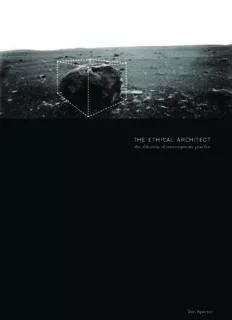
The Ethical Architect: The Dilemma of Contemporary Practice PDF
Preview The Ethical Architect: The Dilemma of Contemporary Practice
THE ETHICAL ARCHITECT the dilemma of contemporary practice Tom Spector THE ETHICAL ARCHITECT THE ETHICAL ARCHITECT the dilemma of contemporary practice tom spector PRINCETON ARCHITECTURAL PRESS NEW YORK For Susan and for Hugh and with the deepest gratitude to Sam and Virginia Spector published by Princeton Architectural Press 37 East Seventh Street New York, New York 10003 For a free catalog of books, call 1.800.722.6657. Visit our web site at www.papress.com. ©2001 Princeton Architectural Press All rights reserved Printed and bound in the United States 04 03 02 01 5 4 3 2 1 First edition No part of this book my be used or reproduced in any manner without written permission from the publisher, except in the context of reviews. Every reasonable attempt has been made to identify owners of copyright. Errors or omissions will be corrected in subsequent editions. Project editing: Clare Jacobson Text editing: Nancy Eklund Later Design: David Konopka Special thanks to: Nettie Aljian, Ann Alter, Amanda Atkins, Jan Cigliano, Jane Garvie, Mark Lamster, Anne Nitschke, Lottchen Shivers, Jennifer Thompson, and Deb Wood of Princeton Architectural Press —Kevin C. Lippert, publisher Library of Congress Cataloging-in-Publication Data Spector, Tom, 1957- The ethical architect : the dilemma of contemporary practice / Tom Spector. p. cm. Includes bibliographical references and index. ISBN 1-56898-284-4 (hardcover : alk. paper)— ISBN 1-56898-285-2 (paperback : alk. paper) 1. Architects—Professional ethics. 2. Architecture— Moral and ethical aspects. I. Title. NA1995 .S68 2001 174'.972--dc21 2001002302 CONTENTS INTRODUCTION VIII PRACTICE 1 THEORY 33 UTILITAS 63 VENUSTAS 89 FIRMITAS 127 CONTEXT 157 STYLE 185 EPILOGUE 203 NOTES 210 BIBLIOGRAPHY 232 INDEX 244 ACKNOWLEDGMENTS This book owes much to the generous access and support given me by the faculty in the Department of Philosophy at the University of California, Berkeley. In particular, chapter one derived much of its impetus from the guidance(and forbearance) of Samuel Scheffler and chapter six benefited similarly from that of Richard Wollheim. Much to my good fortune, Bernard Williams, whose father was an architect, agreed to be on my dis- sertation committee. The work on that project formed the basis of this book. Professor Williams was especially helpful in guiding me through some of the roughest spots of chapter four. Many thanks are also due for the support and perseverance of the members of my committee from the College of Architecture at Berkeley: W. Mike Martin, Jean-Pierre Protzen, and my chair- man, Stephen Tobriner. In particular, Professor Protzen’s com- ments on chapter three helped correct the worst of its omissions and chapter five would not have been possible without Professor Tobriner’s depth on the subject of seismic design. Furthermore, it was a suggestion of Professor Tobriner’s that led to the overall organization of this inquiry around the Vitruvian values of utili- VI tas, firmitas, and venustas. The participation of the Structural Engineers’ Association of Northern California and the comments and perspectives contributed by Bret Lizundia, Charles Bloszies, and Nick Forell were crucial for the development of chapter 5. THEETHICALARCHITECT Finally, I would like to thank Clare Jacobson and Nancy Eklund Later at the Princeton Architectural Press for their commitment to this project during the past year. The book was enhanced immeasurably by their careful editing and enthusiastic guidance. VII THEETHICALARCHITECT INTRODUCTION Architecture’s moral mission reached the nadir of its decline in the 1970s, after the critiques of modernism formulated by Jane Jacobs and Robert Venturi unleashed a thoroughgoing repudiation of the movement’s moral pretensions. The revolutionary ideal of solving societal problems through design that was so vehemently proclaimed by modernism’s proponents in the heroic age of the 1930s was exposed as hollow, and the architecture profession fell into a state of ethical disarray. In 1979, when the mandatory code of ethics of the American Institute of Architects (AIA) was withdrawn under threat of anti-trust action by the Justice Department, the profession seemed little more than a self-serving business venture. Architecture’s failure to address the real problems faced by users of the built environment, as perceived from within and without, left its core design values in shambles. By 1987, the AIAhad managed to craft a new code of ethics that more closely resembled a statement of values than a monopolistic restraint of trade, but the postmodern critique of modern architecture’s shortcomings had further eroded VIII consensus on architecture’s central design values. Other critics joined the fray: social scientists questioned the legitimacy of professional morality; feminists and minorities articulated architecture’s many unspoken coercions; disability-rights activists successfully portrayed the existing conditions of the built environment as an evil to be legislated against. Given such demoralizing circumstances, the esoteric doctrine of deconstruction easily gained a toehold, with its denial of any connection at all between design and moral value. Rather than quell architects’ sense of moral unease, however, this development only served to fracture still further the idea that architectural design could coalesce around a core mission or statement of purpose. Architects live and work today in a functioning but weakened profession that lacks a dominant design ethic. Views regarding the desirability of this development within the field span the gamut, from “good riddance to unwanted baggage” to a nostalgic desire to recapture the sense of purpose and idealism with which the masters of modernism and their champions swept the world off its feet. An opportunity to examine unquestioned assumptions regarding the morality of professional practice and the value of design has emerged. The past can be mined both for its good ideas and for its bad IX examples, and a future of possible convergence upon a durable, substantial, and robust design ethic can be imagined. A conversation about the content of a design ethic reflective of architecture’s core values has persisted. For the
Description: